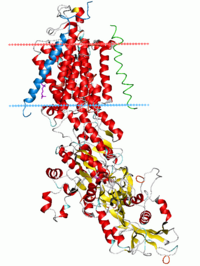
Photo from wikipedia
Cadmium (Cd) is detrimental to animals, but nephrotoxic effects of Cd on duck have not been fully elucidated. To evaluate the impacts of Cd on Ca homeostasis and autophagy via… Click to show full abstract
Cadmium (Cd) is detrimental to animals, but nephrotoxic effects of Cd on duck have not been fully elucidated. To evaluate the impacts of Cd on Ca homeostasis and autophagy via PLC‐IP3‐IP3R pathway, primary duck renal tubular epithelial cells were exposed to 2.5 μM and 5.0 μM Cd, and combination of 5.0 μM Cd and 10.0 μM 2‐APB or 0.125 μM U‐73122 for 12 h (U‐73122 pretreated for 1 h). These results evidenced that Cd induced [Ca2+]c overload mainly came from intracellular Ca store. Cd caused [Ca2+]mit and [Ca2+]c overload with [Ca2+]ER decrease, elevated Ca homeostasis related factors (GRP78, GRP94, CRT, CaN, CaMKII, and CaMKKβ) expression, PLC and IP3 activities and IP3R expression, but subcellular Ca2+ redistribution was reversed by 2‐APB. PLC inhibitor U‐73122 dramatically relieved the changes of the above indicators induced by Cd. Additionally, U‐73122 obviously reduced the number of autophagosomes and LC3 accumulation spots, Atg5, LC3A, LC3B mRNA levels and LC3II/LC3I, Beclin‐1 protein levels induced by Cd, and markedly elevated p62 mRNA and protein levels. Overall, the results verified that Cd induced [Ca2+]c overload mainly originated from ER Ca2+ release mediated by PLC‐IP3‐IP3R pathway, then triggered autophagy in duck renal tubular epithelial cells.
Journal Title: Environmental Toxicology
Year Published: 2022
Link to full text (if available)
Share on Social Media: Sign Up to like & get
recommendations!